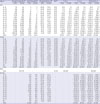1. Theorell T, Hammarström A, Aronsson G, Träskman Bendz L, Grape T, Hogstedt C, et al. A systematic review including meta-analysis of work environment and depressive symptoms. BMC Public Health. 2015; 15(1):738.

2. Bonde JP. Psychosocial factors at work and risk of depression: a systematic review of the epidemiological evidence. Occup Environ Med. 2008; 65(7):438–445.

3. Stansfeld S, Candy B. Psychosocial work environment and mental health--a meta-analytic review. Scand J Work Environ Health. 2006; 32(6):443–462.

4. Kivimäki M, Nyberg ST, Batty GD, Fransson EI, Heikkilä K, Alfredsson L, et al. Job strain as a risk factor for coronary heart disease: a collaborative meta-analysis of individual participant data. Lancet. 2012; 380(9852):1491–1497.
5. Nyberg ST, Fransson EI, Heikkilä K, Alfredsson L, Casini A, Clays E, et al. Job strain and cardiovascular disease risk factors: meta-analysis of individual-participant data from 47,000 men and women. PLoS One. 2013; 8(6):e67323.

6. Fransson EI, Nyberg ST, Heikkilä K, Alfredsson L, Bjorner JB, Borritz M, et al. Job strain and the risk of stroke: an individual-participant data meta-analysis. Stroke. 2015; 46(2):557–559.
7. Nyberg ST, Fransson EI, Heikkilä K, Ahola K, Alfredsson L, Bjorner JB, et al. Job strain as a risk factor for type 2 diabetes: a pooled analysis of 124,808 men and women. Diabetes Care. 2014; 37(8):2268–2275.

8. Babu GR, Jotheeswaran AT, Mahapatra T, Mahapatra S, Kumar A Sr, Detels R, et al. Is hypertension associated with job strain? A meta-analysis of observational studies. Occup Environ Med. 2014; 71(3):220–227.

9. Gilbert-Ouimet M, Trudel X, Brisson C, Milot A, Vézina M. Adverse effects of psychosocial work factors on blood pressure: systematic review of studies on demand-control-support and effort-reward imbalance models. Scand J Work Environ Health. 2014; 40(2):109–132.

10. Lang J, Ochsmann E, Kraus T, Lang JW. Psychosocial work stressors as antecedents of musculoskeletal problems: a systematic review and meta-analysis of stability-adjusted longitudinal studies. Soc Sci Med. 2012; 75(7):1163–1174.

11. Forouzanfar MH, Alexander L, Anderson HR, Bachman VF, Biryukov S, Brauer M, et al. Global, regional, and national comparative risk assessment of 79 behavioural, environmental and occupational, and metabolic risks or clusters of risks in 188 countries, 1990–2013: a systematic analysis for the Global Burden of Disease Study 2013. Lancet. 2015; 386(10010):2287–2323.
15. Samsung Economic Research Institute. Conditions for healthy company: mental health of workers.
KJ Lee
. CEO Information. Seoul, Korea: Samsung Economic Research Institute;2012. p. 1–3.
17. Sultan-Taïeb H, Lejeune C, Drummond A, Niedhammer I. Fractions of cardiovascular diseases, mental disorders, and musculoskeletal disorders attributable to job strain. Int Arch Occup Environ Health. 2011; 84(8):911–925.

18. Sultan-Taïeb H, Niedhammer I. Evaluating the burden of job stress from the public-health and economic viewpoints: perspectives and methodological pitfalls. Travail et Emploi. 2013; 5(1):45–54.
19. Levin ML. The occurrence of lung cancer in man. Acta Unio Int Contra Cancrum. 1953; 9(3):531–541.
20. Nurminen M, Karjalainen A. Epidemiologic estimate of the proportion of fatalities related to occupational factors in Finland. Scand J Work Environ Health. 2001; 27(3):161–213.

21. Ministry of Health & Welfare. Suicide Prevention White Book. Seoul, Korea: Ministry of Health & Welfare;2015.
22. Karasek RA. Job demands, job decision latitude, and mental strain: implications for job redesign. Adm Sci Q. 1979; 24(2):285–308.

23. Lu ML, Nakata A, Park JB, Swanson NG. Workplace psychosocial factors associated with work-related injury absence: a study from a nationally representative sample of Korean workers. Int J Behav Med. 2014; 21(1):42–52.

24. Parent-Thirion A, Fernández Macías E, Hurley J, Vermeylen G. Fourth European Working Conditions Survey. Dublin, Ireland: European Foundation for the Improvement of Living and Working Conditions;2006.
25. Kivimäki M, Kawachi I. Work stress as a risk factor for cardiovascular disease. Curr Cardiol Rep. 2015; 17(9):630.

26. Fransson EI, Nyberg ST, Heikkilä K, Alfredsson L, Bjorner JB, Borritz M, et al. Job strain and the risk of stroke: an individual-participant data meta-analysis. Stroke. 2015; 46(2):557–559.
27. Theorell T, Hammarström A, Aronsson G, Träskman Bendz L, Grape T, Hogstedt C, et al. A systematic review including meta-analysis of work environment and depressive symptoms. BMC Public Health. 2015; 15(1):738.

28. Jauregui M, Schnall PL. Schnall PL, Dobson M, Rosskam E, editors. Work, psychosocial stressors and the bottom line, unhealthy work. New York, NY: Baywood Publishers;2009. p. 153–167.
29. Walter SD. The distribution of Levin's measure of attributable risk. Biometrika. 1975; 62(2):371–372.

30. Salomon JA, Haagsma JA, Davis A, de Noordhout CM, Polinder S, Havelaar AH, et al. Disability weights for the global burden of disease 2013 study. Lancet Glob Health. 2015; 3(11):e712–23.

32. Seoul National University College of Medicine. The Epidemiological Survey of Mental Disorders in Korea 2011. Seoul, Korea: Ministry of Health and Welfare;2012.
34. Kauppinen T, Toikkanen J, Pukkala E. From cross-tabulations to multipurpose exposure information systems: a new job-exposure matrix. Am J Ind Med. 1998; 33(4):409–417.

35. LaMontagne AD, Keegel T, Vallance D, Ostry A, Wolfe R. Job strain - attributable depression in a sample of working Australians: assessing the contribution to health inequalities. BMC Public Health. 2008; 8(1):181.

36. Sultan-Taïeb H, Chastang JF, Mansouri M, Niedhammer I. The annual costs of cardiovascular diseases and mental disorders attributable to job strain in France. BMC Public Health. 2013; 13(1):748.

37. Ministry of Health & Welfare, Korea Centers for Disease Control and Prevention. Korea Health Statistics 2011: Korea National Health and Nutrition Examination Survey (KNHANES). Seoul, Korea: Ministry of Health & Welfare;2012.
39. Kim AS, Johnston SC. Global variation in the relative burden of stroke and ischemic heart disease. Circulation. 2011; 124(3):314–323.

40. Hong KS, Kim J, Cho YJ, Seo SY, Hwang SI, Kim SC, et al. Burden of ischemic stroke in Korea: analysis of disability-adjusted life years lost. J Clin Neurol. 2011; 7(2):77–84.








 PDF
PDF Citation
Citation Print
Print




 XML Download
XML Download